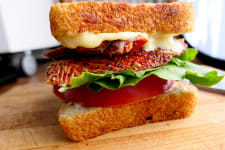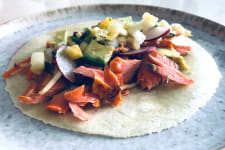A good wild-caught seafood meal is a feast for the senses, tantalizing your eyes, nose, and taste buds. Why not round things out and add in texture to cover your sense of touch and even sound with a crunchy, crispy crust? Breading your wild-caught seafood, or using alternatives to breadcrumbs, is one way to turn your meals into a full-on sensory experience.
Here are some common themes you’ll see in recipes for breaded or crusted wild-caught seafood.
Classic Breading for Crusts
Using breadcrumbs or panko (a coarser, Japanese-style breadcrumb) is a classic approach to building a crust on your wild-caught seafood. In most cases, you’ll want to bake rather than fry anything that is breaded so that your fillets will stay succulent inside while having enough time to get deliciously golden and crispy on the outside.
For a super low-maintenance crust, try BBC Good Food’s recipe for lemon-herb crusted white fish (use whichever fillet you prefer). You’ll make a seasoned breadcrumb mixture from lemon zest, parsley, and parmesan to sprinkle onto your fish after you’ve seared one side of it in an oven-safe pan, moving the entire skillet to the oven to broil (the recipe says “grill,” but in this context it’s British English for broiler) until your crust is browned.
Martha Stewart’s recipe for crunchy panko-crusted salmon also integrates lemon zest into its breadcrumb mixture — the citrus zest just works really nicely with seafood and breadcrumbs — but rather than sprinkling on top of your fillet, you’ll dredge the salmon in flour and eggs before coating the entire thing with toasted panko and baking the fish in the oven.
Similarly, this recipe from The Kitchn uses the same technique but is made with rockfish or cod and has an East Asian-inspired twist.
A buttery, herbed panko crust tops this fillet of halibut in Food Network’s recipe, which is roasted on a bed of swiss chard. There’s no dredging for this one, just a layer of mayo which will serve to keep your halibut moist as well as help the breadcrumbs adhere to the fillet.
Nutty Crusts for Fish
Using nuts to create a crust on your wild-caught seafood can transform your dish in three ways. For one thing, it adds a distinctively nutty texture and satisfying crunch. Additionally, using a nut crust adds another layer of flavor to the dish. Beyond flavor, nuts also pack healthy fatty acids that add to the overall fat profile of your meal.
For a classic amandine-like preparation, try this gluten-free recipe from Kettle and Fire for rockfish baked with a slivered almond crust. There’s no dredging required; instead, the almonds will stick to an herbed mustard mixture that you’ll slather onto the fillets before baking.
Erik Akis’ recipe for a halibut sheet pan dinner uses a mixture of roasted, crushed cashews and panko to create a crust that complements its Asian-inspired flavors. The halibut is baked alongside broccoli until the fillets are cooked through and its topping is golden brown.
While technically not a nut, shredded coconut will give your recipe a similar hit of flavor, fatty acids, and texture. Chef Jessica Bright uses sweetened coconut as a crust for her Caribbean-inspired recipe of fried fish, first dipping the fillets into a beer batter, then coating them in coconut before lowering them into hot oil. You can use any firm, white fillet you like for this recipe.
Unexpected Crust Alternatives
Using anything from spices to cereals to potato chips, you’ll see that you can turn practically anything into a crust on your wild-caught seafood, as long as your ingredients fare well in a hot pan or hot oven.
The Spruce Eats uses cornflakes for its cereal-crusted cod recipe. To get the cornflakes to stick, you’ll first dredge the fillets in a mustard-egg mixture, then coat in cereal before baking the fish in the oven.
Though this simple dish from Mama Gourmand for oven fried white fish is baked, using potato chips in the crust gives it a faux fried appeal and rice chex for added texture. There’s some parmesan mixed into the coating for extra flavor as well, which will melt down and give the crust even more crunch.
Ming Tsai uses freshly ground coriander as the crust for this Asian-fusion halibut recipe, supercharging the recipe with herbaceous flavor while adding a light crunch to the fillet. As with the previous recipe, the halibut is cooked on the stovetop until just seared on both sides before it is transferred to the oven, where it will finish without burning the coriander.






